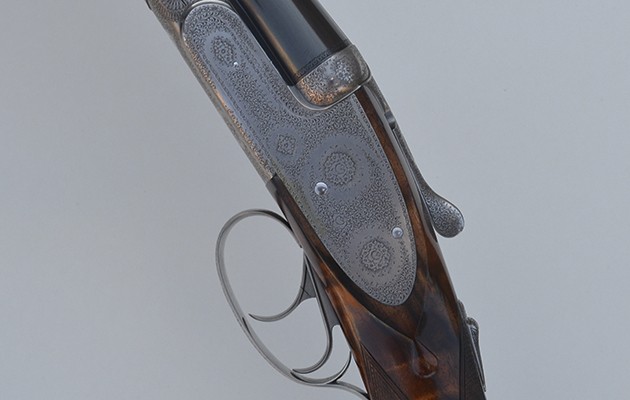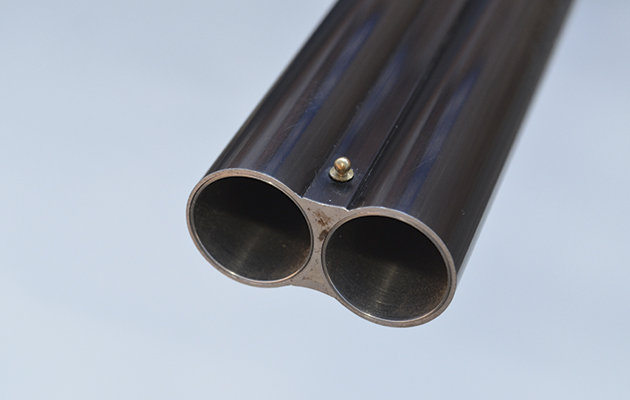Michael Yardley tests an imported demonstration model and admires the elegance, functionality and refinement of the Bosis Queen
Bosis Queen
The Bosis Queen 20- bore sidelock ejector imported by Victor Chapman is this month’s test gun. It’s the firm’s premium side-by-side and traditionally bench-made in Travagliato near Brescia. As an elegant, functional and refined gun, it gets Michael Yardley’s approval.
BOSIS QUEEN
The Bosis Queen, a superior-grade gun, has 30in chopper-lump barrels, double triggers (the front of which is articulated) and fine rose-and-scroll engraving on a coin-finished action. It weighs 61⁄4lb and balances – with a longer than average stock – just a little to the rear of its hinge pin. The price of this lightly used demonstrator is £24,000 including VAT (a bespoke, gun would cost from about £40,000.
Aesthetically, the tasteful engraving by Naida Martinelli pleases. The general form of the gun is good. There are several subtle features. The action is a semi-round bar with double-beaded edges to its belly and the more usual beaded fences. The quick-detachable lock plates are semi-pinless. Only three are visible on the left lock: the front pin/peg for the mainspring, the stud-axle for the tumbler and the top of the pin/screw that holds the locks in place (seen as a lever on the right side).
The barrels of the Bosis Queen – which are 23⁄4in (70mm) chambered – bear Italian proof marks. They are well presented with competent striking up and appear good internally. The concave rib is of a narrow type and fitted with an elegant and practical small brass front bead. Flush-fitting Teague chokes, retro-fitted in the UK, are just visible at the muzzles. Careful viewing reveals that the shadow circles within them are not absolutely concentric, so the bores are not quite true. Perfection in this department is rarely achieved on smaller bores (including London’s best).
BOSIS QUEEN: GOOD DESIGN
Nevertheless, good design of the Bosis Queen with regard to weight distribution and expert striking up of the barrels combine with the action type to provide a pleasing balance with weight between the hands but also enough weight forward to give a sense of control. This is a quality difficult to achieve.
The stock ticks nearly all boxes, too. The wood is well selected with bold “fiddle-back” figure and strong, straight grain, through the hand. Shapes are efficient. The comb supports the cheek effectively. The fore-end fills the hand, as does the oval grip. I was aware of the nose of the stock comb impacting the base of my thumb slightly. Because the comb itself is a good size, it is not excessively tapered forward, thus the nose is quite prominent. For my hand, it needed a little more relieving. The stock dimensions were 153⁄8in for length with an extra 1⁄8in and 3⁄8in at heel and toe respectively. I was delighted to see a proper “bump” at heel (too rarely encountered) which secures the gun at the shoulder and obviates any tendency to slip on mounting or in recoil.
Drop was less than average at 13⁄8in and just under 2in. Some right-hand cast was in evidence. When Chapman orders for the shelf he normally specifies a length of pull of just over 15in and drop of 11⁄2in and 2in. He notes, “The Bosis Queen is a best-quality, London-pattern, sidelock ejector with particularly elegant stock and action shapes. Bosis is one of the most respected names left in Italy. I’ve imported over 50 of their guns. Luciano [Bosis] is a great gunmaker with a passion for his work. He is a shooting man paying particular attention to practical shooting qualities.”
BOSIS QUEEN: TECHNICAL DATA
The Bosis Queen has Holland & Holland-style lockwork with intercepting safety sears and Southgate ejector work. It is not an assisted opener but otherwise owes its inspiration to the Holland & Holland Royal. This is often the pattern for side-by-side guns made on the Continent. The recognisable shape of the sidelock owes its inspiration to Beesley’s design of 1880, the rights to which were acquired by Purdey. Other makers struggled to find a way around this brilliant patent. Holland & Holland eventually came up with its own refined design in the early 1890s. It featured lock plates similar in appearance to the Purdey but with different internal mechanisms. Unlike the Purdey, the Holland & Holland gun did not use one limb of the lock spring to power the tumbler
and the other as a self-opening feature. The only function of the mainsprings in the Holland & Holland design is to drive the hammers forward.
BOSIS QUEEN: SHOOTING IMPRESSIONS
If I were to order a 20 bore side-by-side it would probably have a specification much like the test gun save for a flat, file-cut, rib and, perhaps, a few ounces more weight. Handled dry, the Bosis Queen inspired confidence with good purchase and pointability. It had a solid but lively quality. Shooting it was no disappointment, either. The gun was precise to use with crisp triggers. It felt refined. Recoil was not excessive. At 15.8mm the bores were not as tight as some; the forcing cones were not sharp and blended well into the bores. The stock shapes were particularly comfortable and efficient. I liked the rounded drop points, too; I have blistered my hand on sharper ones (one famous London marque often does this to me in recoil).
Overall, a well-conceived, well-finished gun at a discounted price. A gun to be shot.
BOSIS QUEEN SIDE-BY-SIDE
Price: £24,000 incl VAT
From: Victor Chapman, 121 London Road, Marks Tey, Colchester, Essex, CO6 1EB
Tel: 01206 213068









